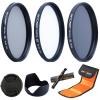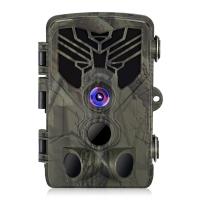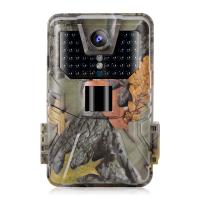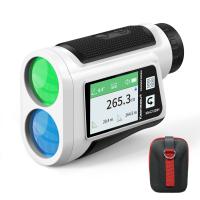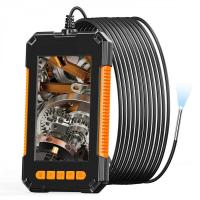Wireless Hunting Trail Cameras
- days
- :
- hours
- :
- min
- :
- sec
- * KF35.133 =KF35.127S1=KF35.127V1+KF28.0011*2+KF42.0013 Long-range WIFI connectivity for remote monitoring:With a WIFI distance of 20 meters outside, you can easily monitor your hunting trail camera from a distance.
- * Flexible timing shooting function for better results:The timing shooting function allows you to set the camera to take pictures or videos at specific intervals, ranging from 3 seconds to 24 hours.
- * High thermal IR sensitivity for better night vision:With a thermal IR sensitivity of 65ft/20m, the camera can capture clear images and videos even in low-light conditions.
- * Versatile 3-pod interface for easy installation:The 1/4" standard interface makes it easy to install the camera on a tripod or other mounting device.
- * Long fill light irradiation distance for better image quality:With a fill light irradiation distance of 65ft/20m, the camera can capture clear images and videos even in complete darkness.
2. Get free gift over $100 (select on the checkout page).
3. Get a 20% OFF code after ordered (Each account may only participate once).
Wireless hunting trail cameras are devices that are used to capture images and videos of wildlife in their natural habitat. These cameras are equipped with wireless technology that allows them to transmit the images and videos they capture to a remote location, such as a smartphone or computer. This makes it possible for hunters and wildlife enthusiasts to monitor the activity of animals in real-time, without having to physically be present in the area.
Wireless hunting trail cameras are typically battery-powered and can be set up in a variety of locations, such as trees or posts. They are equipped with motion sensors that trigger the camera to start recording when an animal enters the frame. The images and videos captured by these cameras can be used for a variety of purposes, such as tracking animal behavior, monitoring population trends, and identifying potential hunting locations.
Overall, wireless hunting trail cameras are a valuable tool for hunters and wildlife enthusiasts who want to gain a better understanding of the animals in their area. They provide a non-invasive way to observe wildlife and can help to inform conservation efforts.

Common problems:
1. Error in image transmission: Sometimes, the wireless hunting trail camera may fail to transmit images due to poor network connectivity or other technical issues. To solve this, ensure that the camera is placed in an area with strong network coverage. Also, check the camera's settings to ensure that it is properly configured for wireless transmission.
2. Battery drain: Wireless hunting trail cameras rely on batteries for power, and sometimes the batteries may drain faster than expected. To solve this, use high-quality batteries and ensure that the camera is not left on for extended periods when not in use.
3. Image quality issues: Poor image quality can be caused by a variety of factors, including low lighting, camera settings, and lens quality. To solve this, ensure that the camera is properly configured for the lighting conditions in the area where it is placed. Also, check the camera's settings to ensure that it is set to capture high-quality images.
4. Camera placement issues: Sometimes, the camera may be placed in an area that is not ideal for capturing images. This can result in missed shots or poor image quality. To solve this, carefully choose the location where the camera is placed, taking into account factors such as lighting, distance, and angle.
5. Technical malfunctions: Like any electronic device, wireless hunting trail cameras can experience technical malfunctions. To solve this, ensure that the camera is properly maintained and serviced regularly. Also, keep the camera away from extreme temperatures and other environmental factors that may damage it.

Product Advantages:
1. Convenience: Wireless hunting trail cameras offer the convenience of not having to physically retrieve the camera to view the images or videos captured. This saves time and effort, especially in remote or hard-to-reach locations.
2. Real-time monitoring: With wireless connectivity, hunters can monitor their hunting grounds in real-time, allowing them to make informed decisions about when and where to hunt.
3. Improved accuracy: Wireless hunting trail cameras can capture high-quality images and videos, providing hunters with more accurate information about the animals in their hunting grounds. This can help them make better decisions about which animals to target and when.
4. Reduced disturbance: Since hunters don't have to physically retrieve the camera, they can avoid disturbing the animals in their hunting grounds. This can help maintain the natural behavior of the animals and improve the overall hunting experience.
5. Increased safety: Wireless hunting trail cameras can help hunters monitor their hunting grounds for potential safety hazards, such as trespassers or dangerous animals. This can help prevent accidents and ensure a safer hunting experience.
6. Cost-effective: While wireless hunting trail cameras may have a higher upfront cost than traditional cameras, they can be more cost-effective in the long run. Since hunters don't have to physically retrieve the camera, they can save on travel costs and reduce the wear and tear on their vehicles. Additionally, wireless cameras can be more durable and require less maintenance than traditional cameras.

Maintenance:
1. Regularly check the battery life: Wireless hunting trail cameras rely on batteries to function, so it's important to regularly check the battery life to ensure that the camera is functioning properly. Replace the batteries as needed to avoid any disruptions in the camera's performance.
2. Keep the camera clean: Dirt, dust, and debris can accumulate on the camera lens and affect the quality of the images. Use a soft cloth to clean the lens and the camera body regularly to ensure that the camera is functioning at its best.
3. Protect the camera from the elements: Wireless hunting trail cameras are often used in outdoor environments, so it's important to protect them from the elements. Use a waterproof case or cover to protect the camera from rain, snow, and other weather conditions.
4. Check the camera's settings: Wireless hunting trail cameras have a variety of settings that can affect the quality of the images. Check the camera's settings regularly to ensure that they are optimized for the environment and the type of images you want to capture.
5. Update the camera's firmware: Manufacturers often release firmware updates for their cameras to improve performance and fix bugs. Check for firmware updates regularly and install them as needed to keep the camera functioning at its best.
6. Have the camera serviced regularly: Even with regular maintenance, cameras can develop problems over time. Have the camera serviced by a professional technician regularly to ensure that it is functioning properly and to address any issues before they become more serious.

Product features:
1. Long Battery Life: Wireless hunting trail cameras should have a long battery life to ensure that they can operate for extended periods without needing to be recharged or have their batteries replaced. This feature is essential because hunters often leave their cameras in remote locations for days or even weeks at a time, and they need to be confident that the camera will continue to function throughout this period.
2. High-Quality Images: Wireless hunting trail cameras should be capable of capturing high-quality images that are clear and detailed. This feature is essential because hunters rely on these images to identify and track game animals. The camera should have a high-resolution sensor, a fast shutter speed, and a high-quality lens to ensure that the images are sharp and detailed.
3. Wireless Connectivity: Wireless hunting trail cameras should have built-in wireless connectivity, such as Wi-Fi or Bluetooth, to enable hunters to access the images remotely. This feature is essential because it allows hunters to monitor their cameras from a distance, reducing the need for them to visit the camera site frequently. The camera should also have a mobile app that allows hunters to view and download the images easily.
4. Durable and Weatherproof: Wireless hunting trail cameras should be durable and weatherproof to withstand the harsh outdoor conditions. This feature is essential because the camera will be exposed to rain, snow, and extreme temperatures. The camera should be made of high-quality materials that can withstand these conditions and have a waterproof and dustproof rating to ensure that it remains functional in all weather conditions. Additionally, the camera should have a camouflage design to blend in with the environment and avoid detection by game animals.

Product parameters:
Interface : USB; TF memory card socket
Motion Sensing Delay : 3 seconds-10 minutes (default 30 seconds)
3-Pod Interface : 1/4" standard interface
Thermal IR Sensitivity : 65ft/20m
Working mode : Video
Timing shooting function : 3 seconds - 24 hours
Exposure control : Automatic
WIFI distance : 20 meters outside
Monitoring period setting : 0-24 hours
Fill light irradiation distance : 65ft/20m
- All Reviews
- Image










